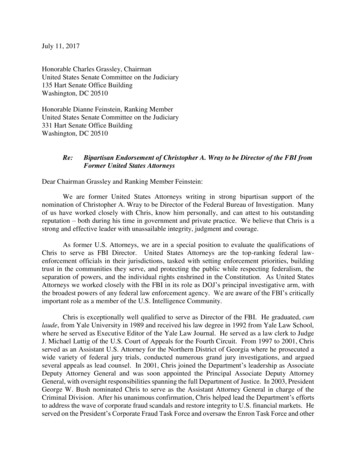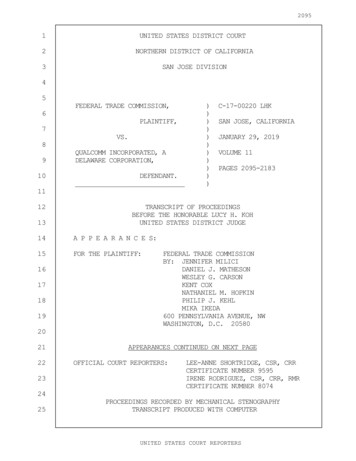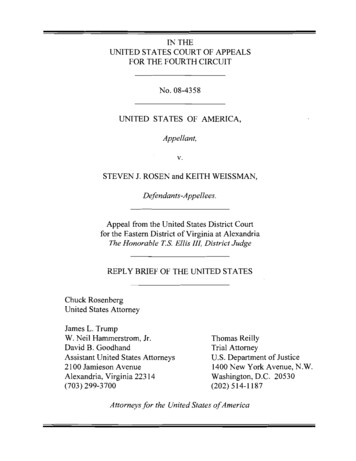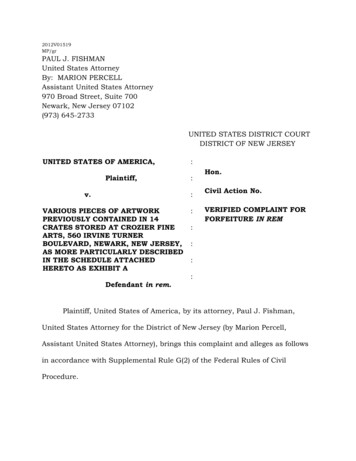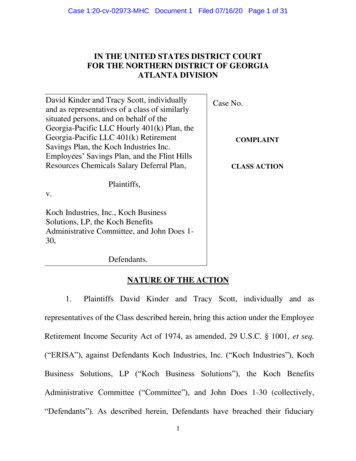
Transcription
Case 1:20-cv-02973-MHC Document 1 Filed 07/16/20 Page 1 of 31IN THE UNITED STATES DISTRICT COURTFOR THE NORTHERN DISTRICT OF GEORGIAATLANTA DIVISIONDavid Kinder and Tracy Scott, individuallyand as representatives of a class of similarlysituated persons, and on behalf of theGeorgia-Pacific LLC Hourly 401(k) Plan, theGeorgia-Pacific LLC 401(k) RetirementSavings Plan, the Koch Industries Inc.Employees’ Savings Plan, and the Flint HillsResources Chemicals Salary Deferral Plan,Case No.COMPLAINTCLASS ACTIONPlaintiffs,v.Koch Industries, Inc., Koch BusinessSolutions, LP, the Koch BenefitsAdministrative Committee, and John Does 130,Defendants.NATURE OF THE ACTION1.Plaintiffs David Kinder and Tracy Scott, individually and asrepresentatives of the Class described herein, bring this action under the EmployeeRetirement Income Security Act of 1974, as amended, 29 U.S.C. § 1001, et seq.(“ERISA”), against Defendants Koch Industries, Inc. (“Koch Industries”), KochBusiness Solutions, LP (“Koch Business Solutions”), the Koch BenefitsAdministrative Committee (“Committee”), and John Does 1-30 (collectively,“Defendants”). As described herein, Defendants have breached their fiduciary1
Case 1:20-cv-02973-MHC Document 1 Filed 07/16/20 Page 2 of 31duties with respect certain Koch-affiliated defined contribution plans (“Plans”)1 inviolation of ERISA, to the detriment of the Plans and their participants andbeneficiaries. Plaintiffs bring this action to remedy this unlawful conduct and obtainappropriate monetary and equitable relief as provided by ERISA.PRELIMINARY STATEMENT2.As of June 2020, Americans had approximately 7.9 trillion in assetsinvested in defined contribution plans, such as 401(k) and 403(b) plans. 2 Definedcontribution plans have largely replaced defined benefit plans—or pension plans—that were predominant in previous generations.3 Only around 8% of non-union U.S.workers in the private sector participate in a defined benefit plan.4 By contrast,approximately 47% of non-union U.S. workers in the private sector participate in a1The Koch-affiliated Plans at issue are the Georgia-Pacific LLC Hourly 401(k) Plan(“Georgia-Pacific Hourly Plan”), the Georgia-Pacific LLC 401(k) RetirementSavings Plan (“Georgia-Pacific Savings Plan”), the Koch Industries Inc. Employees’Savings Plan (“Koch Plan”), and the Flint Hills Resources Chemicals SalaryDeferral Plan (“Flint Hills Plan”).2See Investment Company Institute, Retirement Assets Total 28.7 Trillion in ci.org/research/stats/retirement/ret 20 q1.3See Bankrate, Pensions Decline as 401(k) Plans Multiply (July 24, 2014), availableat s-decline-as-401-k-plansmultiply-1.aspx.4See Congressional Research Service, Worker Participation in Employer-SponsoredPensions: A Fact Sheet, at 4 (Apr. 30, 2019) available athttps://fas.org/sgp/crs/misc/R43439.pdf.2
Case 1:20-cv-02973-MHC Document 1 Filed 07/16/20 Page 3 of 31defined contribution plan.53.The potential for disloyalty and imprudence is much greater in definedcontribution plans than in defined benefit plans. In a defined benefit plan, theparticipant is entitled to a fixed monthly pension payment, while the employer isresponsible for making sure the plan is sufficiently capitalized, and thus theemployer bears all risks related to excessive fees. See Hughes Aircraft Co. v.Jacobson, 525 U.S. 432, 439 (1999). Therefore, in a defined benefit plan, theemployer and the plan’s fiduciaries have every incentive to keep costs low and toremove imprudent investments. But in a defined contribution plan, participants’benefits “are limited to the value of their own investment accounts, which isdetermined by the market performance of employee and employer contributions,less expenses.” Tibble v. Edison Int’l, 135 S. Ct. 1823, 1826 (2015). Thus, theemployer has no incentive to keep costs low because all risks related to high feesare typically borne by the participating employees.4.To safeguard retirement plan participants, ERISA imposes strictfiduciary duties of loyalty and prudence upon employers and other plan fiduciaries.29 U.S.C. § 1104(a)(1). These twin fiduciary duties are the “highest known to law.”Pledger v. Reliance Tr. Co., 240 F. Supp. 3d 1314, 1321 (N.D. Ga. 2017) (quotingITPE Pension Fund v. Hall, 334 F.3d 1011, 1013 (11th Cir. 2003)). Fiduciaries5See id.3
Case 1:20-cv-02973-MHC Document 1 Filed 07/16/20 Page 4 of 31must act “solely in the interest of the participants and beneficiaries,” 29 U.S.C. §1104(a)(1)(A), and exercise appropriate “care, skill, prudence, and diligence.” 29U.S.C. § 1104(a)(1)(B). This includes an obligation to ensure that the expenses ofadministering the plan are reasonable. See 29 U.S.C. § 1104(a)(1)(A)(ii).5.Contrary to these fiduciary duties, Defendants failed to prudently andloyally monitor and control the Plans’ recordkeeping expenses, and instead allowedthe Plans to pay up to six times more than what similarly-sized plans would havepaid for such services. Defendants’ ERISA violations have resulted in millions ofdollars in excessive fees to the Plans and their participants since the beginning ofthe statutory period.6.Based on the conduct described herein, Plaintiffs assert claims againstDefendants under ERISA for breaches of the fiduciary duties of loyalty andprudence (Count One), and against Koch Industries for failure to monitor fiduciaries(Count Two). In connection with these claims, Plaintiffs seek to recover all lossesto the Plans resulting from Defendants’ fiduciary breaches and other appropriaterelief.JURISDICTION AND VENUE7.Plaintiffs bring this action pursuant to 29 U.S.C. § 1132(a)(2) and (3),which provide that participants in an employee retirement plan may pursue a civilaction on behalf of the plan to remedy breaches of fiduciary duties and other4
Case 1:20-cv-02973-MHC Document 1 Filed 07/16/20 Page 5 of 31prohibited conduct, and to obtain monetary and appropriate equitable relief as setforth in 29 U.S.C. § 1109.8.This case presents a federal question under ERISA, and therefore thisCourt has subject matter jurisdiction pursuant to 28 U.S.C. § 1331 and 29 U.S.C. §1132(e)(1).9.Venue is proper pursuant to 29 U.S.C. § 1132(e)(2) and 28 U.S.C. §1391(b) because this is the district where the Georgia-Pacific Hourly Plan andGeorgia-Pacific Savings Plan are administered, where Defendant Koch BusinessSolutions resides (according to the 5500s for these two plans), and where asubstantial part of the events or omissions giving rise to the claims occurred.THE PARTIESPLAINTIFFS10. Plaintiff David Kinder resides in Arkadelphia, Arkansas. PlaintiffKinder has participated in the Georgia-Pacific Hourly Plan since 1996, and is acurrent participant in that plan. As a plan participant, his account has been5
Case 1:20-cv-02973-MHC Document 1 Filed 07/16/20 Page 6 of 31recordkept by Alight Financial Advisors (“Alight”)6 during the class period.7Plaintiff Kinder has been financially injured by Defendants’ unlawful conduct, andhis account would be worth more today if Defendants had not violated ERISA asdescribed herein.11. Plaintiff Tracy Scott resides in Arkadelphia, Arkansas, and was aparticipant in the Georgia-Pacific Hourly Plan from approximately 2007 until 2016.As a plan participant, his account was recordkept by Alight during the class period.Plaintiff Scott has been financially injured by Defendants’ unlawful conduct, andhis account would have been worth more at the time it was distributed if Defendantshad not violated ERISA as described herein.THE PLANS IN THE MASTER TRUST12.The Koch Companies Defined Contribution Master Trust (“MasterTrust”) is the single master trust governing several retirement plans for employees6Alight is the legacy provider of certain human resources outsourcing services,including 401(k) administrative services, originally developed by Hewitt Associates.Hewitt was acquired by Aon in 2010, and Aon spun off recordkeeping and otherHewitt service lines into Alight in 2017. After the spinoff, Alight is a privatecompany no longer affiliated with Aon. As used herein, “Alight” refers to both thecurrent company and its predecessors.7The class period is limited to the period on or after July 16, 2014, see infra at ¶ 50,pursuant to ERISA’s six-year statute of limitations, see 29 U.S.C. § 1113(1).6
Case 1:20-cv-02973-MHC Document 1 Filed 07/16/20 Page 7 of 31of Koch affiliated companies, including the Georgia-Pacific Hourly Plan,8 theGeorgia-Pacific Savings Plan,9 the Koch Plan,10 and the Flint Hills Plan.1113. The Plans are “employee pension benefit plan[s]” within the meaningof 29 U.S.C. § 1002(2)(A) and “defined contribution plan[s]” within the meaningof 29 U.S.C. § 1002(34). The Plans are qualified plans under 26 U.S.C. § 401,commonly referred to as “401(k) plan[s].”14. “[A] master trust is a trust for which a regulated financial institutionserves as trustee or custodian (regardless of whether such institution exercisesdiscretionary authority or control respecting the management of assets held in thetrust) and in which assets of more than one plan sponsored by a single employer orby a group of employers under common control are held.” 29 C.F.R. § 2520.1031(e).15. “The use of master trusts by large employers is commonplace . Thesingle administrative device simplifies the conduct of multiple plans, prevents8The Georgia-Pacific Hourly Plan covers eligible hourly paid employees or formeremployees of Georgia-Pacific LLC (“Georgia-Pacific”) or its affiliates. GeorgiaPacific is a wholly-owned subsidiary of Koch Industries.9The Georgia-Pacific Savings Plan covers eligible employees and former employeesof Georgia-Pacific or its affiliates. As noted above, Georgia-Pacific is a whollyowned subsidiary of Koch Industries.10The Koch Plan covers eligible employees or former employees of Koch Industriesor other companies affiliated with Koch Industries.11The Flint Hills Plan covers certain groups of union employees or formeremployees of Flint Hills Resources, LLC (“Flint Hills Resources”). Flint HillsResources is a wholly-owned subsidiary of Koch Industries.7
Case 1:20-cv-02973-MHC Document 1 Filed 07/16/20 Page 8 of 31duplication of effort and expense, and creates economies of scale.”1216. The Plans have all participated in the Master Trust since at least 2009.1317. With the exception of assets held in certain self-directed brokerageaccounts and common collective trust funds, the Plans hold all of their investmentassets in the Master Trust.18. The Plans participating in the Master Trust are managed together. TheMaster Trust gives common access to the same investment options and services forall the Plans. The Plans’ participants may direct their accounts to one or more of theinvestment vehicles selected by Defendants within the Master Trust’s investmentmenu.19. From the beginning of 2014 until the end of 2018, the Plans have hadbetween approximately 53,000 and 60,000 participants, and the Master Trust hasUnited States Securities and Exchange Commission (“SEC”) Docket Volume ks.google.com/books?id 1aiCkO3RGBUC&pg PA1499&lpg PA1499&dq master trust economies of scale.&source bl&ots Pt2PXa5srK&sig ACfU3U0eEHXbZDhSc3O8Z5j4qgfvMP58FA&hl en&sa X&ved 2ahUKEwiw cnPkqrqAhXNB80KHfN9AiMQ6AEwEnoECAgQAQ#v onepage&q master%20trust%20economies%20of%20scale.&f false.13The Flint Hills Resources Chemicals Money Purchase Pension Plan and the MolexIncorporated Retirement and Savings Plan also participate in the Master Trust.However, the Flint Hills Resources Chemicals Money Purchase Pension Plan’sfilings with the United States Department of Labor (“DOL”) do not indicate that itpaid any compensation to Alight for recordkeeping services. The MolexIncorporated Retirement and Savings Plan did not start participating in the MasterTrust until 2018.128
Case 1:20-cv-02973-MHC Document 1 Filed 07/16/20 Page 9 of 31had between 6.5 billion and 8.1 billion in assets.DEFENDANTSKoch Industries, Inc.20. Koch Industries is a private company headquartered in Wichita,Kansas.21. Koch Industries is identified as the plan sponsor and plan administratorin the Master Trust’s Form 5500s filed with the DOL. Koch Industries has ultimatedecision-making authority with respect to the Master Trust and the managementand administration of the Master Trust and the Master Trust’s investments. Further,since all of the Plans are managed together and have the same investment optionsthrough the Master Trust, Koch Industries has decision-making authority withrespect to the Plans, the management and administration of the Plans, and the Plans’investments. Because Koch Industries exercises discretionary authority ordiscretionary control with respect to management and administration of the MasterTrust and Plans, and with respect to disposition of the assets of the Master Trustand Plans, it is a functional fiduciary under 29 U.S.C. § 1002(21)(A).22. To the extent that Koch Industries has delegated any of its fiduciaryfunctions to others, such as the Committee or Koch Business Solutions, itmaintained fiduciary responsibilities with respect to the Plans and the Master Trust.It is well-accepted that the authority to appoint, retain, and remove other fiduciaries9
Case 1:20-cv-02973-MHC Document 1 Filed 07/16/20 Page 10 of 31constitutes discretionary authority or control over the management oradministration of a plan or trust, and thus confers fiduciary status under 29 U.S.C.§ 1002(21)(A). See 29 C.F.R. § 2509.75-8 (D-4); Coyne & Delany Co. v. Selman,98 F.3d 1457, 1465 (4th Cir. 1996) (“[T]he power to appoint, retain and removeplan fiduciaries constitutes ‘discretionary authority’ over the management oradministration of a plan within the meaning of § 1002(21)(A).”). Further, theresponsibility for appointing and removing other fiduciaries carries with it anaccompanying duty to monitor the appointed fiduciaries, and to ensure that they arecomplying with ERISA’s fiduciary standards. See 29 C.F.R. § 2509.75-8 (FR-17);Coyne, 98 F.3d at 1465 (The power to appoint and remove plan fiduciaries “carrieswith it a duty to monitor appropriately those subject to removal.”) (quotationomitted).23. Koch Industries possessed the ability to delegate its fiduciaryresponsibilities to any other person, persons, or entity. Any individuals or entitiesnot named in this Complaint to whom Koch Industries delegated fiduciary functionsor responsibilities are also fiduciaries of the Plans under 29 U.S.C. §§ 1002(21)(A)and 1105(c)(2). Because any such individuals or entities that have been delegatedfiduciary responsibilities are not currently known to Plaintiffs, they are collectivelynamed in this Complaint as John Does 1-10.10
Case 1:20-cv-02973-MHC Document 1 Filed 07/16/20 Page 11 of 31Koch Business Solutions, LP24. Koch Business Solutions is an information technology servicescompany located in Atlanta, Georgia. Koch Business Solutions offers finance,human resources, facilities, real estate, and other technology support to variousbusinesses including Koch Industries, Georgia-Pacific, and Flint Hills Resources(collectively, the “Companies”).25. The Plans’ Form 5500 filings direct plan sponsor and plan administratorcommunications to Koch Business Solutions.26. The Companies have delegated the Plans’ fiduciary administrativefunctions to Koch Business Solutions. Because Koch Business Solutions exercisesdiscretionary authority or discretionary control with respect to management andadministration of the Plans, it is a functional fiduciary under 29 U.S.C.§ 1002(21)(A).Koch Benefits Administrative Committee27. The Koch Benefits Administrative Committee is a committeedesignated to assist Koch Industries with administration of the Plans. TheCommittee has the duty to select, monitor, evaluate, and modify the Plans’investments, subject to the ultimate oversight and discretion of Koch Industries. Inperformance of its duties, the Committee exercises “authority or control respectingmanagement or disposition” of the Plans’ assets and has “discretionary authority or11
Case 1:20-cv-02973-MHC Document 1 Filed 07/16/20 Page 12 of 31discretionary responsibility in the administration” of the Plans, and is therefore afiduciary under 29 U.S.C. § 1002(21)(A).28. Each of the Committee members are also fiduciaries under 29 U.S.C. §1002(21)(A). Because the names of the individual members of the Committeeduring the class period are currently unknown to Plaintiffs, they are collectivelynamed in this Complaint as John Does 11-30.29. Each Defendant identified above as a fiduciary of the Plans is alsosubject to co-fiduciary liability under 29 U.S.C. § 1105(a)(1)–(3) because itparticipated in the other fiduciaries’ breaches, enabled other fiduciaries to breachtheir fiduciary duties, and/or failed to remedy other fiduciaries’ breaches of theirduties, despite having knowledge of the breaches. See Woods v. S. Co., 396 F. Supp.2d 1351, 1378-79 (N.D. Ga. 2005) (“ERISA § 405(a) provides that a fiduciary canbe liable for another fiduciary’s breach in circumstances where (1) he participatesknowingly in, or knowingly undertakes to conceal, an act or omission of such otherfiduciary, knowing such act or omission is a breach; (2) by his failure to complywith § 404(a) in the administration of his specific responsibilities which give rise tohis status as a fiduciary, he has enabled such other fiduciary to commit a breach; or(3) he has knowledge of a breach by such other fiduciary, unless he makesreasonable efforts under the circumstances to remedy the breach.”) (quotations12
Case 1:20-cv-02973-MHC Document 1 Filed 07/16/20 Page 13 of 31omitted).ERISA FIDUCIARY DUTIES30. ERISA imposes strict fiduciary duties of loyalty and prudence uponfiduciaries of retirement plans. 29 U.S.C. § 1104(a)(1) states, in relevant part:[A] fiduciary shall discharge his duties with respect to a plan solely in theinterest of the participants and beneficiaries and—(A)for the exclusive purpose of(i)providing benefits to participants and their beneficiaries;(ii)defraying reasonable expenses of administering the plan;and(B)with the care, skill, prudence, and diligence under thecircumstances then prevailing that a prudent man acting in a likecapacity and familiar with such matters would use in the conductof an enterprise of like character and with like aims . . . .31. These ERISA fiduciary duties are “the highest known to law.” Pledger,240 F. Supp. 3d at 1321 (quoting ITPE Pension Fund, 334 F.3d at 1013). Afiduciary’s conduct “must bear the marks of loyalty, skill, and diligence expectedof an expert in the field. It is not enough to avoid misconduct, kickback schemes,and bad-faith dealings. The law expects more than good intentions. A pure heartand an empty head are not enough.” Sweda v. Univ. of Pennsylvania, 923 F.3d 320,329 (3d Cir. 2019) (quotation omitted).13
Case 1:20-cv-02973-MHC Document 1 Filed 07/16/20 Page 14 of 31DUTY OF LOYALTY32. The duty of loyalty requires fiduciaries to act with “an eye single” tothe interests of plan participants. Pegram v. Herdrich, 530 U.S. 211, 235 (2000).“Perhaps the most fundamental duty of a [fiduciary] is that he [or she] must display. . . complete loyalty to the interests of the beneficiary and must exclude all selfishinterest and all consideration of the interests of third persons.” Id. at 224 (quotingG Bogert et al., Law of Trusts and Trustees § 543 (rev. 2d ed. 1980)). “There is nobalancing of interests; ERISA commands undivided loyalty to the planparticipants.” Karpik v. Huntington Bancshares Inc., 2019 WL 7482134, at *4 (S.D.Ohio Sept. 26, 2019) (quoting Bedrick by & Through Humrickhouse v. TravelersIns. Co., 93 F.3d 149, 154 (4th Cir. 1996)).DUTY OF PRUDENCE33. ERISA also “imposes a ‘prudent person’ standard by which to measurefiduciaries’ investment decisions and disposition of assets.” Fifth Third Bancorp v.Dudenhoeffer, 134 S. Ct. 2459, 2467 (2014) (quotation omitted). “[A] fiduciary’sconduct at all times must be reasonably supported in concept and must beimplemented with proper care, skill, and caution.” Sweda, 923 F.3d at 333(quotation omitted). “[I]f there is indeed a ‘hallmark’ of fiduciary activity identifiedin the statute, it is prudence.” Id.14
Case 1:20-cv-02973-MHC Document 1 Filed 07/16/20 Page 15 of 31DUTY TO MINIMIZE COSTS34. At retirement, employees’ benefits “are limited to the value of their ownindividual investment accounts, which is determined by the market performance ofemployee and employer contributions, less expenses.” Tibble, 135 S. Ct. at 1826.“Expenses, such as management or administrative fees, can sometimes significantlyreduce the value of an account in a defined-contribution plan, by decreasing itsimmediate value, and by depriving the participant of the prospective value of fundsthat would have continued to grow if not taken out in fees.” Sweda, 923 F.3d at 328(quotation omitted).1435. Administrative services such as recordkeeping, trustee, and custodialservices are necessary for the operation of any defined contribution plan and areone of the plan’s largest expenses. To protect retirement plan participants, ERISArequires the fiduciaries of such plans to monitor administrative expenses and ensurethat they are reasonable. See 29 U.S.C. § 1104(a)(1)(A)(ii) (“[A] fiduciary shalldischarge his duties solely in the interest of participants for the exclusive14The DOL and SEC have warned that although the fees and costs associated withinvestment products and services may seem small, over time they can have asignificant impact on an investor’s portfolio. See DOL, A Look at 401(k) Plan Fees,at 1-2 (2013), available at look-at-401k-plan-fees.pdf(cautioning that 1% difference annually can reduce the investor’s account balance atretirement by 28%); SEC Investor Bulletin, How Fees and Expenses Affect ps://www.sec.gov/investor/alerts/ib fees expenses.pdf.15
Case 1:20-cv-02973-MHC Document 1 Filed 07/16/20 Page 16 of 31purpose of[] providing benefits and defraying reasonable expenses ofadministering the plan[.]”); Sweda, 923 F.3d 3at 328 (“Fiduciaries must understand and monitor plan expenses.”); accord Restatement (Third) of Trusts §88, cmt. a (2007) (“Implicit in a trustee’s fiduciary duties is a duty to be costconscious.”).1536. Given the significant variation in total plan costs attributable to plansize, the reasonableness of administrative expenses, including recordkeeping fees,should be determined by comparisons to other similarly-sized plans. See 29 U.S.C.§ 1104(a)(1)(B) (requiring ERISA fiduciaries to discharge their duties in themanner “that a prudent man acting in a like capacity and familiar with such matterswould use in the conduct of an enterprise of a like character”); Tussey v. ABB, Inc.,2007 WL 4289694, at *6, n.5 (W.D. Mo. Dec. 3, 2007) (Plaintiffs sufficientlyalleged that administrative expenses were unreasonable through comparisons tosimilar plans because “[a]t most, reasonable compensation should meancompensation commensurate with that paid by similar plans for similar servicesto unaffiliated third parties.”) (quoting Nell Hennessy, Follow the Money: ERISAPlan Investments in Mutual Funds and Insurance, 38 J. Marshall L. Rev. 867, 877The legal construction of an ERISA fiduciary’s duties is “derived from thecommon law of trusts.” Tibble, 135 S. Ct. at 1828 (citation and internal quotationmarks omitted). Therefore “[i]n determining the contours of an ERISA fiduciary’sduty, courts often must look to the law of trusts.” Id.1516
Case 1:20-cv-02973-MHC Document 1 Filed 07/16/20 Page 17 of 31(2005)).37. A fiduciary may breach its fiduciary duty by authorizing higher-thanmarket recordkeeping fees or by maintaining a recordkeeping deal for its ownbenefit or that of a related party. See Tussey v. ABB, Inc., 746 F.3d 327, 336 (8thCir. 2014) (affirming judgment against plan sponsor based on “overpaying”recordkeeper and benefiting from the overpayment); George v. Kraft Foods Glob.,Inc., 641 F.3d 786, 799 (7th Cir. 2011) (failure to solicit bids, and higher-thanmarket recordkeeping fees, supported triable fiduciary breach claim); see alsoPledger, 240 F. Supp. 3d at 1330 (“If a fiduciary charges record keeping fees , itcan be a breach of its fiduciary duty to fail to monitor fees and rein in excessivecompensation.”); Henderson v. Emory Univ., 252 F. Supp. 3d 1344, 1353 (N.D. Ga.2017) (“The defendants can be held accountable for failing to monitor and makingsure that the recordkeepers charged appropriate fees and did not receiveoverpayments for their services.”).DEFENDANTS’ VIOLATIONS OF ERISAI.DEFENDANTS FAILED TO PROPERLY MONITORRECORDKEEPING EXPENSES.ORCONTROLTHEPLANS’38. Defendants, through the Master Trust, caused the Plans’ participants topay excessive recordkeeping expenses during the class period.39. Among larger plans, the market for recordkeeping services is highlycompetitive, with many recordkeepers equally capable of providing a high-level17
Case 1:20-cv-02973-MHC Document 1 Filed 07/16/20 Page 18 of 31service. Accordingly, recordkeepers vigorously compete for business by offeringthe best price. As a result of such competition, recordkeeping fees have declined indefined contribution plans over time. Between 2006 and 2016, recordkeeping costsin the marketplace dropped by approximately 50% on a per-participant basis.1640. Typically, recordkeepers charge for recordkeeping services either on aper-participant fee basis (a fee based on the number of participants in the plan) oras an asset-based fee (a fee based on a percentage of the total assets in the plan).17Regardless of how these fees are charged, the cost of these services is typicallyborne by the plan participants. Accordingly, it is important for plan fiduciaries toclosely monitor these expenses to ensure that participants are not beingovercharged. See DOL Advisory Op. 2013-03A, 2013 WL 3546834, at 4 (July 3,2013) (noting that fiduciaries must obtain information regarding “all fees orcompensation received by” a recordkeeper – “including any revenue sharing” – andassess whether that amount is reasonable for the services provided).41. The cost of providing recordkeeping services depends on the numberof participants in a plan. Plans with large numbers of participants can take16See Greg Iacurci, Adjusting to the Squeeze of Fee Compression, Investment News(Nov. 9, 2019) available at eeze-of-fee-compression-170635 (“Median fees for record-keeping, trust andcustody services for DC plans fell by about half in the decade through 2017,according to most recent figures published by consulting firm NEPC.”).17Asset-based fee arrangements are more common for smaller defined contributionplans, which have less leverage to negotiate how services are charged.18
Case 1:20-cv-02973-MHC Document 1 Filed 07/16/20 Page 19 of 31advantage of economies of scale by negotiating lower per-participant recordkeepingfees. Similarly, plans with smaller numbers of participants can take advantage ofeconomies of scale (and negotiate lower per-participant recordkeeping fees)through collective participation in a master trust.42. As noted above, the Plans have had between 53,000 and 60,000participants, and the Master Trust has had between 6.5 billion and 8.1 billion inassets during the class period. Accordingly, the Plans, through the Master Trust,have significant leverage to negotiate recordkeeping expenses.43. Defendants, through the Master Trust, have caused the Plans topurchase recordkeeping services from Alight. Alight has been the recordkeeper forthe Plans since 2009. The fees incurred for recordkeeping services are allocatedbetween the Plans based upon each plan’s proportionate share of the assets in theMaster Trust.44. Koch Industries has a close relationship with Alight. In addition toacting as the recordkeeper for the Plans, Alight has also administered the KochIndustries Employees’ Pension Plan since 200918 and administers Koch Industries’online benefits portal through which all employee benefits are managed, among18Similarly, Alight administers the Georgia-Pacific LLC Hourly Pension Plan, theGeorgia-Pacific LLC Salaried Pension Plan, and the Flint Hills Resources GroupBenefit Plan.19
Case 1:20-cv-02973-MHC Document 1 Filed 07/16/20 Page 20 of 31other things.19 Unlike the defined contribution Plans at issue, where recordkeepingexpenses are paid out of participants’ assets, the costs of providing these pensionplan and benefits services are the responsibility of Koch Industries.45. Based on the Plans’ filings with the DOL, the recordkeeping fees forthe Plans were at least 58-146 per participant in 2014; 72-95 per participant in2015; 64-84 per participant in 2016; 59-83 per participant in 2017; and 53-86per participant in 2018.20 Based on Plaintiffs’ investigation, a prudent and loyalfiduciary of a similarly-sized plan could have obtained comparable recordkeepingservices of like quality for as low as 14 per participant during that same timeperiod. See Moitoso v. FMR LLC, 2020 WL 1495938, at *15 (D. Mass. Mar. 27,2020).46. A prudent fiduciary would have closely monitored the Plans’recordkeeping expenses and engaged in a rigorous benchmarking analysis, eitheron its own or by working with an independent consultant, and would have19Koch Industries Online MyLifeChoices Benefits Portal, available outing (last visited July 14, 2020).20This is based on the information currently available to Plaintiffs. Thesecalculations are likely conservative as they only account for the direct compensationpaid to Alight, and do not account for indirect compensation such as revenue sharing.Form 5500s filed by the Plans with the
determined by the market performance of employee and employer contributions, less expenses." . including 401(k) administrative services, originally developed by Hewitt Associates. Hewitt was acquired by Aon in 2010, and Aon spun off recordkeeping and other . 13 The Flint Hills Resources Chemicals Money Purchase Pension Plan and the Molex





